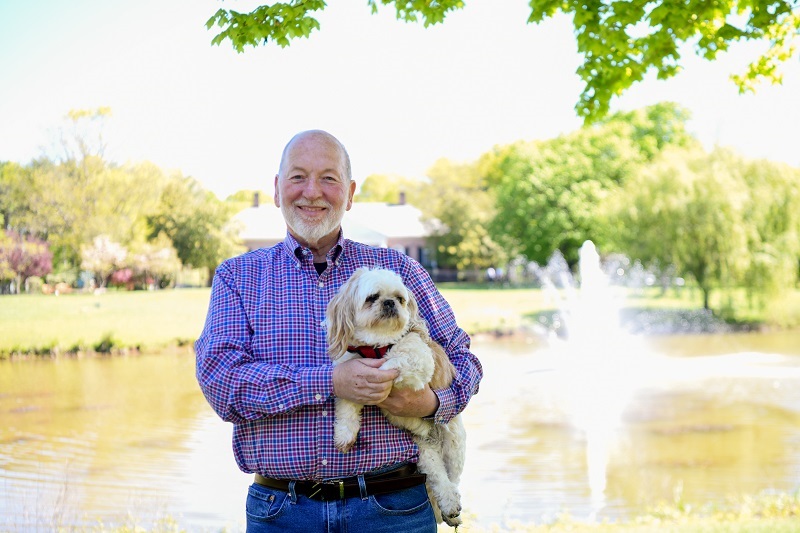Colts Neck, NJ, Recovers After “Widowmaker” Heart Attack

June 16, 2023
In May 2022, Dan Reiss was enjoying a walk with his dog, Jake, near his home in Colts Neck, New Jersey when he heard an unrecognizable female voice in his head tell him distinctly, “You’re having a heart attack.”
Incredibly confused, Dan, who was 68 at the time, spotted a police station under construction and a temporary office trailer nearby and went up the stairs to knock on a window, feeling “nothing unusual,” he says. Someone opened the door as he asked for a glass of water and then proceeded to fall over. His heart stopped from a severe “widowmaker” heart attack, dubbed this name because it’s unusual for people to survive them.
Using an automated external defibrillator (AED) that was inside the trailer, police electrically shocked his heart three times before re-establishing an effective rhythm. He was then transported in an ambulance, with accompanying police escort, to Jersey Shore University Medical Center in cardiogenic shock. His heart couldn’t pump enough blood and oxygen to the brain and other vital organs, which is considered a life-threatening emergency.
Dan had a minor heart attack 30 years ago, took medication to control high blood pressure, got regular check-ups and underwent stress tests every few years. He was vigilant about his self-care and said he had no warning signs of the life-changing event that was about to occur.
State-of-the-Art Devices Save His Life
So began Dan’s challenging multi-step medical journey in heart failure that required six procedures. As explained by his cardiothoracic surgeon, Deepak Singh, M.D., first Dan received an intra-aortic balloon pump (IABP) in the hospital’s cardiac catheterization lab.
The cardiac team, without Dr. Singh present at that point, used the IABP to open Dan’s blocked left anterior descending artery, the body’s largest coronary artery. He also received a cardiac stent, a small mesh tube to hold open passages such as weak or narrowed arteries. However, Dan continued to deteriorate because blood couldn’t move freely through that artery.
It was time for another plan, Dr. Singh says. The interventional cardiologists then implanted an Impella CP heart pump through Dan’s right groin. The mechanical circulatory support treats cardiogenic shock and is considered a temporary measure that requires the patient to lie flat all the time.
Dan recovered for a brief time, enough for the first Impella CP to be removed. But he crashed, requiring implantation of a second device, this time through his left groin. “Dan demonstrated he could not stay off a device and was in multisystem organ failure that also required a ventilator,” Dr. Singh recalls.
The team needed a long-term strategy “to pull Dan out of the fire,” Dr. Singh says. The team determined that to be an Impella 5.5-liter pump. Dr. Singh positioned it under Dan’s right collarbone to connect it to the axillary artery, the principal artery of the upper limb.
‘On the Bridge’ to a Heart Transplant
Dan was off the ventilator a week after implantation, and off dialysis approximately three weeks later, spending 33 days in the intensive care unit. He still needed one more device as a “bridge” to a heart transplant, and Dr. Singh chose a durable left ventricular assist device, or LVAD, placed through the breastbone during surgery.
Within three weeks, Dan could walk with assistance for 1,000 steps, and in four weeks, on his own. “Time with the LVAD allowed his organs to recover completely so he could be listed for a transplant,” Dr. Singh says.
Dan learned to manage having a cable—called a driveline—that exited the skin on his abdomen and connected to the LVAD controller outside of his body that runs the pump. He also adapted to creative showering techniques, since he was not allowed to get external components of the LVAD wet.
Dan’s characteristic upbeat approach to life shone through even in difficult times. He says his wife, son and daughter have been phenomenal support, as was the hospital nursing staff.
“Ironically, in some ways, I looked better with my LVAD than before the incident, unless you noticed the batteries, which I wore in my T- shirt,” he says. Dan kept track of their power level to avoid failure and another medical emergency.
Ready to be a ‘Normal Person’ Again
Dan says Dr. Singh not only took care of him, but also spent time encouraging his family. “The best doctors are able to be personable while being incredibly talented,” Dan says. “Dr. Signh also arranged for me to see a respected heart transplant surgeon.”
He had said that with a new heart, “I’m looking forward to being a ‘normal person’ again.”
On May 7, 2023, Dan received that new heart, and within a day of surgery, his new heart was beating successfully, and he was breathing on his own and even speaking a bit.
After knocking on the trailer, Dan doesn’t remember much about what transpired, but today, he’s looking forward to many more years of walks with Jake.
Next Steps & Resources:
- Meet our source: Deepak Singh, M.D.
- To make an appointment with a cardiologist near you, call 800-822-8905 or visit our website.
- Schedule a heart screening near you
- Learn more about our heart care services
The material provided through HealthU is intended to be used as general information only and should not replace the advice of your physician. Always consult your physician for individual care.





